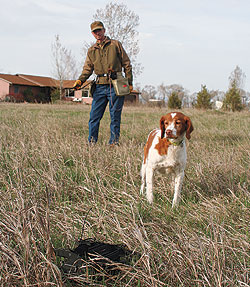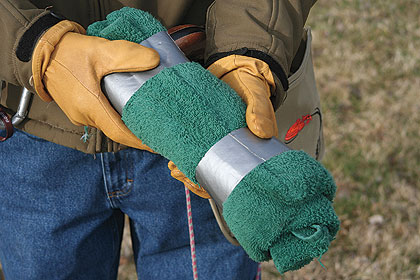There's more than one way to correct your dog.
By Dave Carty
 Being ready to instantly administer a correction if the dog breaks — in this case, a Brittany pointing a bird in a releaser — is critical to consistent training efforts. |
When I was a kid I lived on what had once been an Iowa farm, with a pasture, riding ring and several barns. It wasn't long before my two sisters and I convinced our parents to let us have horses, which I rode until I discovered bird dogs.
But it wasn't my fleeting fascination with the equine world I remember, but rather something I'd overheard some grownups say. To get a horse's attention, I'd been told, you had to "hit it over the head with a shovel." That was pretty extreme even by the standards of the small, rural town I grew up in, but I swallowed it whole.
It was a long time before I really examined the conventional wisdom I'd been taught. I never hit anything over the head with a shovel, not my dogs, not my horses, and my sisters only when they deserved it. (Note to Mom: that was a joke. Really.) But that kind of thinking--that hard physical punishment is how you trained animals--stayed with me longer than I like to admit.
Still, in the last 20 years I've gradually come 180 degrees on disciplining dogs. I like to think that, contrary to what prominent psychologists and most of my friends would tell you, I've evolved. Certainly, of the many types of corrections available to a trainer, physical punishment--at a level commensurate with the infraction, and not an iota more--is one of the tools at your disposal. But with many, if not most, dogs, a mild correction or a sharp rebuke is all they'll ever need.
The key to choosing the type of correction you use, and how much of it to apply, is determined by the situation and your reading of the dog. Is he willfully disobeying you?
Or is he merely confused? The first requires a quick, sharp correction; the second requires patience.
You can go a long way toward lessening your dog's confusion by making sure it understands one command thoroughly before moving its training on that particular command to the next level. Trainer George Hickox calls that understanding a benchmark.
A benchmark is a level at which your dog is absolutely confident, and to which he'll return if he's confused. As you raise the bar and expand his training on any command, new benchmarks are formed, assuming you train him thoroughly at each succeeding level.
This accomplishes two things: It builds your dog's confidence, and it dramatically lessens his confusion. For this type of training--and for nearly all the field training I do--an e-collar is invaluable for nudging the dog in the right direction. The dog learns to turn off mild, not punishing, stimulation by performing the command correctly, over and over again.
 Picking up the dog and returning him to the spot where he broke is a highly effective method of reinforcing steadiness. |
But let's say that, after several weeks of successful "whoa" work in the yard, your dog decides, apropos of nothing, that he's no longer going to obey your command. A tap on his e-collar, at a somewhat higher level, is appropriate here. If that gets the job done, immediately dial the collar back down to the training level he's become accustomed to, then repeat the command again.
In the field, on actual birds, I'd handle such an infraction differently, at least at first. If a dog breaks while pointing a planted bird, I would physically pick him up and carry him back to where the infraction occurred, then set him sharply back down on the ground.
Don't ask me why this works, but it does, particularly when done simultaneously with a collar correction. Only as a last resort would I dial up the collar, and only if picking up the dog and replacing him had failed several times.
In many other situations not involving live birds, all that may be needed is a sharp "no!" Long-winded explanations to your dog about why such and such a behavior isn't going to fly go in one canine ear and out the other.
But there is a way you can make a verbal correction more effective, and it starts in the house with basic citizenship training. Keep a rolled-up towel handy, and when your puppy decides to use your favorite leather recliner as a chew toy, hurl the towel at him, and as soon as it hits him, immediately follow with a loud "no!"
The towel thumping his ribs won't hurt him a bit, but it will startle him, and the quick verbal rebuke will sink in that much more. This has worked wonders with my new English pointer puppy, and it should work for you, too, assuming you've got a good throwing arm. After he's been towel-thumped and rebuked a few times, your pup will know that he needs to stop whatever it is he's doing immediately when he hears the word "no!"
When administering any correction, verbally or electronically, it's important that you do so while the dog is actually engaged in whatever it is you want him to stop doing, and the closer you administer the reprimand to when he begins that behavior, the better. In other words, telling your dog "no!" the instant he reaches out to chew your recliner is more effective than waiting until after he's been gnawing on it a while; likewise, correcting your dog with a collar the instant he breaks on a pointed bird is more effective than waiting until the bird is gone and he's chasing it.
A reprimand given a few seconds after the fact may still work, especially on an older dog who has developed the mental faculties to process the information you're giving him, but nothing works as well as catching a dog the instant he decides to screw up.
How does this play out? Here's an example: Every summer I train a couple new dogs, finishing them to whatever level their owners want. Since I spend so much time with them, I get pretty good at reading their behavior. So let's say I've set up a dog on a planted pigeon, told him to "whoa" and now, in the interest of increasing the dog's steadiness, am waiting for him to break so I can administer a correction via the e-collar.
 A rolled-up towel is a handy attention-getter to discourage d ogs from unwanted behavior, especially indoors. |
Note: My dogs have had weeks of collar conditioning at this point, so I'm not worried that they're going to associate the stimulation with the bird under their nose.
One way to correct the dog is to wait until he breaks before hitting the e-collar and, in fact, that's usually what happens. But a better way is to watch the dog carefully, and the moment he begins to settle back on his haunches to spring forward, give him a very light correction with the "nick" button, correcting him just as he is gathering his thoughts in preparation for the leap. Method one works well; method two works better.
Any correction you give, electrical or verbal, is much, much more effective if it's consistent. If, for instance, you verbally reprimand your dog when you catch him chewing on the stock of your Purdey but ignore him the next time he does it, he'll get mixed messages. Is it wrong or not? He doesn't know.
Obviously, there are going to be situations that you can't control, and if your pup decides to gnaw on the leg of your grandmother's antique mahogany tea table when you're not around, you're S.O.L. So the first order of business as a trainer should be to put your dog in a situation where you can correct him instantly, no matter what he does.
For puppies, this means watching them like a hawk when they're allowed to run loose in the house (and keeping your rolled-up towel handy), then putting them back in their crate to cool off when you know you're not going to be around to monitor them. In the training field, this means keeping your thumb on the button of your e-collar so you can make an instant correction the moment your dog disobeys a command.
And during an actual hunt, particularly during a new dog's first season, this means spending as least as much time with your e-collar in your hand as with your gun. Let someone else shoot the birds; reinforcing what you've spent the summer training your dog to do is more important now than ever.
I approach house training, yard training and actual hunts with the same mindset: I expect my dog to disobey my commands, so I do my best to put myself in a position in which I can correct him quickly and efficiently. Then I use whatever correction, and at whatever level, I deem appropriate for the crime: picking the dog up and replacing him if he breaks; correcting him with the collar or with a verbal reprimand for other transgressions.
It's rare for a dog to get it right the first time you correct him for anything. But reprimanding him consistently and efficiently will get the point across far sooner than taking a hit-or-miss approach.
This saves wear and tear on the dog, all to the good. And for reformed trainers like me? It means I can keep the shovel in the tool shed, where it belongs.






